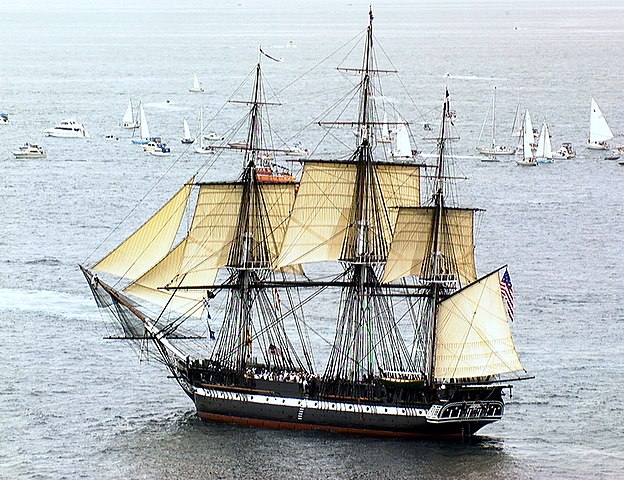This weekend, the U. S. Navy celebrates its 249th birthday. We join in celebrating the U. S. Navy’s birthday this weekend.
In April 1775, British forces launched an operation to seize colonial weapons in Concord, Massachusetts. On the way to Concord, colonials met the British on a field in Lexington. The engagement on that field launched the American Revolutionary War. Other battles followed through 1775. While the British had a formidable army, they were largely a naval power. To win the war, the colonists needed to be able to confront British Naval power.
The U. S. Navy Birthday – Take I: October 13, 1775
In June 1775, Congress appointed George Washington was commander-in-chief of the colonial forces. Washington needed a way to break the stalemate that quickly developed in Boston. While the colonists could keep the British bottled up in Boston, Washington could not attack British supply lines. Likewise, the absence of a naval force complicated colonial resupply. Washington’s response was to lease and arm merchant ships.
On October 13, 1775, the Continental Congress enacted the following resolution. The Continental Congress was effectively the national government of the colonies during the war. The resolution calling for the building of a sailing ship with 10 cannons was Congress’ first act to create colonial naval forces.
Resolved, That a swift sailing vessel, to carry ten carriage guns, and a proportionable number of swivels, with eighty men, be fitted, with all possible despatch, for a cruise of three months, and that the commander be instructed to cruize eastward, for intercepting such transports as may be laden with warlike stores and other supplies for our enemies, and for such other purposes as the Congress shall direct.
That a Committee of three be appointed to prepare an estimate of the expence, and lay the same before the Congress, and to contract with proper persons to fit out the vessel.
Resolved, that another vessel be fitted out for the same purposes, and that the said committee report their opinion of a proper vessel, and also an estimate of the expence.
In December 1775, the Continental Congress authorized the construction of thirteen frigates. The number thirteen was to commemorate the thirteen colonies.
Dismantling of the Navy
British General Cornwallis surrendered at Yorktown on October 19, 1781. This ended the battle for American independence. The Treaty of Paris of 1783 concluded a peace between the former colonies and the British Empire. The former colonists feared a standing (permanent) army or navy. Standing British military forces had been the enforcers of tyrannical British rule. There was little appetite for allowing the same thing to happen again. In August 1785, the Continental Congress sold off the last remaining U. S. Navy ship, effectively ending the Navy.
Road to the U. S. Navy’s Rebirth
Although sentiment was against a significant standing military force, attitudes began to change even as the last U. S. Navy ship was being sold off. In 1785, Algiers captured two American merchant ships off the coast of Northern Africa. Thomas Jefferson, at the time Ambassador to France, believed that the United States needed a maritime force to protect American shipping from piracy. Congress considered proposals to create a Navy but did not take action to do so.
In June 1788, the United States Constitution was ratified. The Constitution explicitly authorized Congress to raise and maintain a Navy.
In 1790, Congress created the Revenue-Marine, a forerunner to the modern Coast Guard. This force was intended to provide customs enforcement. This was not a force capable of challenging pirates operating from North African countries.
By 1793, the United States had lost more than a dozen merchant ships. In January 1794, a bill to construct several ships was introduced in the House of Representatives. Congress passed the Naval Act of 1794 on March 27. In 1796, the United States concluded a peace agreement with Algiers. Under the terms of the Naval Act of 1794, shipbuilding was to stop if peace was established with Algiers. In April 1796, at George Washington’s urging, Congress authorized the completion of the three ships closest to completion – Constitution, Constellation, United States. The Constitution remains on the Navy rolls today.
U. S. Navy Birthday – Take II: April 30, 1798
Congress created the Department of War in 1789. This department was responsible for all of the military affairs of the United States. Secretary of War James McHenry believed that the War Department should be aided by a “commissioner of marine.” Prompted by McHenry, Congress created the Department of the Navy on April 30, 1798.
The Navy Department has jurisdiction over the U. S. Navy and, since 1834, the Marine Corps. In times of war, the Coast Guard also falls under the Navy Department’s jurisdiction.
Military Reorganization in 1947
In 1947, Congress passed the National Security Act of 1947. This law radically restructured the military departments. The National Security Act split the War Department into the Department of the Army and the Department of the Air Force. The Act also created the Department of Defense and placed the Departments of the Army, Air Force, and Navy under the Defense Department.
In 1972, the U. S. Navy birthday was officially recognized as October 13. This commemorates the formation of the Continental Navy as the birth of the U. S. Navy.
Today, the United States Navy is the largest in the world. The Navy boasts approximately 300 combat ships and about 4,000 aircraft. The Navy has over 300,000 active duty sailors, plus a reserve of over 100,000. Today, we acknowledge the commitment and service of the men and women serving in the United States Navy and wish the Navy a Happy Birthday!
